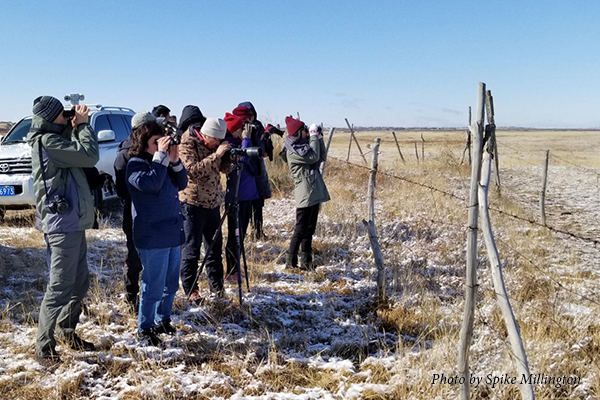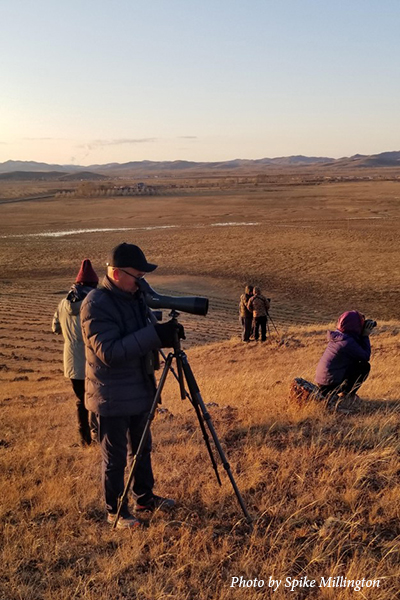White-naped Cranes flying into their night roost near Duolun, Inner Mongolia.
Six hours after leaving the relatively balmy environs of Yeyahu Nature Reserve, just outside Beijing, our bus pulled into Xilinghote, Inner Mongolia, to sub-zero temperatures and light snow. McDonald’s was happily still open and we availed ourselves of the fine cuisine on offer before retiring to our hotel. We were on a quest for White-naped Cranes at their most important staging area on the western flyway. In addition to the International Crane Foundation contingent of myself, Co-founder George Archibald, Director of Conservation Networking Claire Mirande and East Asia Flyways Program Leader Su Liying, Research Associate Nyamba Batbayar and Tseveen Natsagdorj from Mongolia, and Siberian Crane Flyway Coordinator Elena Ilyashenko and Oleg Goroshko from Russia joined the trip. Jia Yifei and two of his interns from Beijing Forestry University rounded out the group. The snowy conditions next morning precluded immediate travel, so we had a meeting with Xilinghote forest bureau officials in the morning, followed by a visit to a nearby primary school in the afternoon and a local college in the evening. I can say that we were enthusiastically received by all levels and ages!

The next day, we set out in convoy, along with a couple of dedicated volunteers and photographers, and local forest police, to a nearby wetland. Baiyinkulun is known for its large colony of nesting Relict Gulls. These were already long gone but we saw 100 White-naped Cranes and flocks of Bean and Greylag Geese. A good start. We then pushed on to Duolun, arriving at Gushanzi in the late afternoon. Here a small hill overlooks a wonderful, hummocky wetland in the valley. First up was a flock of five Great Bustards, then calling cranes. About 150 White-naped Cranes feeding in the valley were joined by an equal number flying into roost as the dusk deepened. A very evocative sight and sound! An early morning count the next day revealed 319 birds, as well as a sole Hooded Crane and a few Eurasian Cranes. We met with Duolun County forestry officials over breakfast. Duolun is seen as an important environmental priority in the fight against desertification and the resultant sandstorms that affect distant Beijing. Tree planting is actively encouraged and indeed tree cover has increased ten-fold in recent years. The county recognizes that wetlands are also important and is in the process of developing a wetland management and protection plan. Hopefully, this will discourage tree planting in the wetlands!

Piling back into the bus, we wound our way along the river floodplain and encountered more flocks of cranes in the agricultural fields. These were mostly Eurasian Cranes, 700 in total, but also 300 White-naped and one Hooded Crane. The birds were different from the roosting cranes, so the total of White-napes was about 700 in the Xilinghote and Duolun areas. We passed Xanadu, closed for the winter, no “stately pleasure dome” on view, and headed back to Beijing in the dark. Nyamba was happy, having seen two of his color-banded birds from Mongolia and he, Tsven and Oleg greatly appreciated the chance to see where their breeding White-naped Cranes stage prior to their continuing journey to winter around Poyang Lake in southeast China. If we want to save declining White-naped Cranes in their western flyway, we need to work with all these areas to protect wetlands and conserve cranes.
 Story submitted by Spike Millington, Vice President International – Asia. Click here to learn more about our work in East Asia.
Story submitted by Spike Millington, Vice President International – Asia. Click here to learn more about our work in East Asia.
